‘Tis the season for bark collecting, again! I’ve been out on my trusty bike visiting all the E Scoparias I know and investigating others that might prove to be (or not to be) E Scoparia. I pull my bike over to pack bark into a bag, trampling on it to crush it and make space for more, and filling again before loading my panniers. Or, go to visit friends with my big bucket in hand and pick up whatever has fallen since my last visit. Or, head out for a run, leaving my rolled up bag under a tree and pick it up to fill on my cool-down walk on the way back. This E Scoparia, tucked in behind the foliage of a carob tree, is peeling lavishly.
At home, I stash the bark in a chook feed sack, offering more opportunities for trampling which let me stack a lot of bark into one bag and get it into a form that will go into the dyepot with minimal fuss.
This week, I found a new E Scoparia (at least, that was my hope). I collected a bag full of bark and it is now soaking so I can test whether I have that right, in consultation with the dyepot. A friend who appreciates natural dyeing lives in this street–so I’ll look forward to telling her if she has a great dye tree at the end of her street! Blackett St:
I also collected bark from this enormous specimen. Last year I collected a lot of bark from this tree and then found I had one bag of bark that gave brown and not red to orange as expected. I suspect that means this is not an E Scoparia. Checking it out again today it is bigger than any other tree I believe to be E Scoparia and it has many more fruits visible and clinging to the stem. My initial sense is that the bark smells different, too. The leaves give fantastic colour (at least they did before someone took a chainsaw to all the lower branches), but I am running a trial bark pot before the tree sheds the main part of its bark. It is soaking alongside the other one as I write. Laught Ave:
Next day, here are the dye baths, three hours in, presented in the same order as the trees from which the bark came. They look remarkably similar but smell quite different:
Here are the (still wet) yarns that came from those dyepots, in the same order again. Clearly, the second tree is not E Scoparia–or–for some reason its context means it doesn’t give the same colour.
As I have had great results from the leaves of that second tree, I pulled the bark out, put some fallen leaves in, and re-dyed the tan skein…!

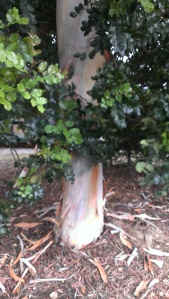
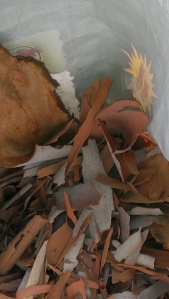
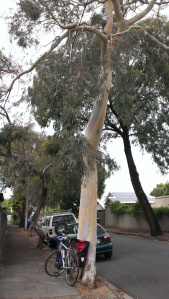
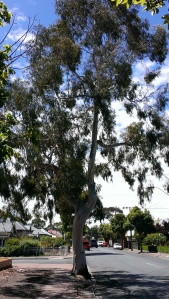
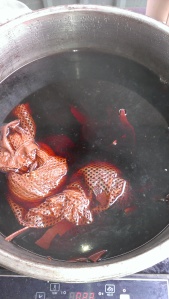
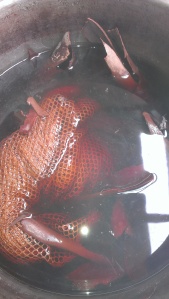
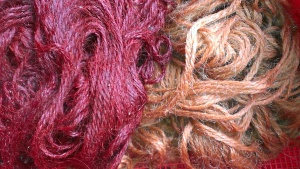
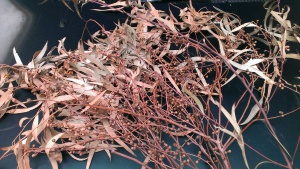
The brownish color you achieved is the same color I get from arbutus bark, a tree that also peels each year.
LikeLike
I just went and looked that tree up on Wikipedia, and finally I see what a Madrone looks like (these I have heard referred to in novels–Madrone seems to be a common name for Arbutus). At least one member of this family grows here. It is often called Irish Strawberry tree. I’ve been suspicious that this might be a slight on the Irish, since the fruit falls well short of the pleasures of a strawberry–but one member of the family is native to Western Ireland according to Wikipedia, so perhaps it’s just descriptive. I’ll see it with new eyes now!
LikeLike
The trick with arbutus fruits, if it’s the same plant I’m thinking of, is to eat them when they’re so ripe that they’re mushy…. riper than one might assume they would be good. At that point, the flesh is a rich dark orange, and they taste not unlike sweet cooked apricots. Very nice indeed! At least, that was how it worked with the one that was growing in the backyard of a house I used to rent, a long time ago.
LikeLike
I’ll give that a try! There is one hanging over a front fence right next door to where I used to live (and where close friends live now)… and sometimes I see them in parks.
LikeLike
I believe the Madrone was used for dyeing baskets by Native Americans historically as well (read it somewhere, can’t remember where).
LikeLike
It’s good to be part of a long tradition, isn’t it?
LikeLike
A quick trawl through the “talk” page for the wikipedia entry on arbutus shows comments by another person to similar effect. The main article describes arbutus fruits as having little flavor, but this person from the talk page apparently made a little mini-project out of trying different arbutus fruits at different stages of ripeness. Apparently they found a lot of variation between trees/strains – some were uninteresting, and some were very good! They say: “The best tree had fruits the size of golf balls, with a taste that ranged, as it ripened, from tart strawberry mixed with melon notes, to a winey almost liquer-like flavor as they disintegrated.”
LikeLike
Goodness! I have never seen a fruit any bigger than a macadamia (out of the shell)! Clearly further investigation on my way through the suburbs is called for 🙂
LikeLike
hate to ask the obvious but have you done a sniff test on the leaves of that second tree? i wonder if they might have a lemony scent…
LikeLike
I think the fact that I have a tag for ‘user error’ says it all about whether I am so confused I think I’m infallible, India! But no, no chance it’s a Lemon Scented Gum. The bark is the wrong colour and texture, the fruits are cup shaped not urn shaped, and about 1/4 the size, and have 3 valves (except when they don’t, since it’s a euc), the leaves are smaller and narrower. And no citronella!
The lemon scented gums around here have shed their pinky-brown bark already to that wonderful smooth olive-y colour that shows off the wrinkles in their elbows so well… and the trees I’m looking for go from ghost white and mealy for most of the year to white/pink/grey just before bark shed and then to a lovely cream. Just can’t describe the difference in smell… don’t have the words–but definitely not lemony.
I was pretty sad when I realised years back that I could definitely identify a lemon scented (by smell if nothing else) and had located many round the neighbourhood and collected their leaves to mulch the chook shed for years… but this was no help in the dyeing project!
LikeLike